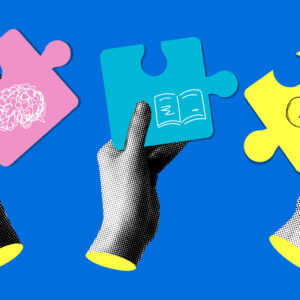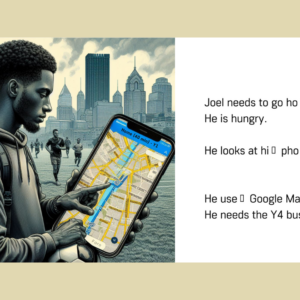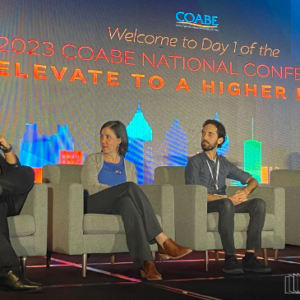Did you participate in the Innovative Digital Learning Models for ELL Immigrant Adults webinar? If so, join the discussion! If not, watch the recording, then join in.
Mobile and other technologies make possible anytime, anywhere learning to extend education to previously underserved adults and to expand learning beyond classroom walls. Technology can also accelerate outcomes through personalized instruction and practice.
In this webinar we highlighted emerging best practices and innovative program models that organizations across the country are using for distance and blended ESL instruction for immigrants and refugees at all skill levels. After watching the webinar, what are your questions about these models? Do you use distance or blended learning in your organization or are you just getting started? Share your questions and stories below.
Poll Results & WebExChat Innovative Digital Learning Models Chat Stream
Presented by Heide Wrigley and Alison Ascher Webber.





13 Comments.
Join the conversation here in the comments!
Do you have any questions about these models or how to incorporate them?
Do you want help brainstorming which models or components might make the most sense for your program or goals?
May I still join? I just finished another meeting…
Hi Dawn, Thank you for your interest! The webinar is posted above in the intro. Please post any questions or thoughts after you see it. Alison
Let’s continue the conversation from today’s webinar! Or if you would rather reach us directly: alison_webber@worlded.org or heide@literacywork.com
What questions or ideas do you have?
Do you have innovative models/approaches you are using you can share?
I am interested in learning more about the process of implementing MobileUp! Is there someone I can contact about this?
Hi Becca, I am the best person to speak to about Mobile Up (alison_webber@worlded.org) as I lead the project in California. See mobileupproject.weebly.com and I would be happy to share anything I can. To contact Cell-Ed about licenses, courses, etc., contact Camille@cell-ed.com
I attended for a while today but had to leave early. Below is a summary of my work with adult Spanish speaking immigrants:
Bridging the Digital Divide – At Last!!
We use the term “Digital Divide” to describe the fact that low-income adults are not able to afford computers or internet service and are therefore unable to access technology as well as they should.
Usually these adults are immigrants who know little or no English, the “low-beginners”.
Well, now there is a solution to this problem that includes:
1. Teaching computer basics in adult literacy classes.
2. Studying “user-friendly” programs in ESL instruction, such as my websites: pumarosa.com and inglesconprofepablo.com.
3. Providing a means for students to own a low-cost computer.
4. Using Smart Phones or cell phones as part of instruction.
5. Providing texts, CDs, and DVDs….and Thumb drives.
6. Advertising – publicity.
I have been working on this problem in my classes at a public library for a year.
And now the students have formed small groups to study in their houses. So I am able to visit each group and put a little more attention on using technology more and more.
In this way a network can be formed that will, finally, Bridge that Digital Divide!!!
Hi Paul, Always love to hear what you’re up to. Bilingual support and instruction is so important and Pumarosa & your other sites (including Facebook groups) are great examples.
Also, I love hearing of students holding study groups in their homes. Similar to English Now model presented in the webinar. When some core instruction can be offered digitally, peer to peer study groups make sense and should be used more. They can be facilitated by peer leaders, volunteers, or staff- but doesn’t necessarily have to be teaching staff- could be for example library staff.
Keep us updated on your work!
Great, Alison!! For those interested in my program, here is an article I just posted on LINCS concerning teaching a multi-level class:
In order to answer the issue of multi-level classes, it is important to find out what materials are available to the students. Do they all have a textbook and a bilingual dictionary? Are computers used in the classroom? Smart phones? What languages do the students speak? How many students are there per class? How old are the students and do they also work at jobs?
To use my class as an example: I teach a multi-level class of Spanish speaking adults, usually women, between the ages of 30 and 65. Almost all of them work and have families. My class is informal in that there are no “requirements” such as attendance. It is also bilingual so that the students have no problem understanding me.
I give out my textbooks to all the students along with CDs and DVDs. The class is in a room with computers where everyone studies Pumarosa.com and other websites.
In this way I can introduce computer basics and now everyone owns a computer for home use. I encourage people to buy used computers at second-hand stores, which are usually in good working condition and also are guaranteed.
Everyone has a smart phone, so I can send them lessons from other websites and my videos.
In this way, the students are able to study lessons at their own level at any time.
During the “live” part of the class, I concentrate on pronunciation and fluency, which all students need. Using my Graded Readers, the students take turns reading out loud.
Using a lot of humor, I primarily “teach” the difficult sounds of G/J, short I, short U, V and Th…
Gradually their pronunciation improves and they all become more fluent – and confident.
At the same time, I introduce short grammar lessons, especially on verb tenses, which are included in my workbooks. I encourage all my students to ask questions, which sooner or later become an important part of the class.
I have just begun to teach these students in small groups at people’s homes. In this way I can give more attention to the use of the computer. It is also a good method to invite new students who are usually friends of the members of the group.
Teaching at home is important for Family Literacy, especially for mothers, who feel a sense of pride in learning how to study with computers, just like their kids!
I have found that in a multi-level class those students who are more “advanced’ tend to help those who are at a lower level. We use the slogan: “Each one teach one.”
I also feel that it is a great way to create a learning atmosphere among the students.
Looking at the poll results and chat stream, there is interest in all the learning models and programs. I am going to invite leaders from the various programs highlighted to introduce themselves here, answer questions, and share more information and resources. Stay tuned…
Hello everyone!
My name is Grazia Mora and I work for Building Skills Partnership, one of the organizations highlighted in the webinar.
We are currently transforming our ESL and Citizenship programs to a blended learning model, experimenting with using tablets and smartphones in the classroom and connecting students with additional resources they can access at home. We try to blend digital literacy and English instruction and have students work on using email, navigate the Internet, use Google Maps, etc. to practice English as well as get comfortable using these apps/features in their daily life.
As mentioned on the webinar, we also run Smartphone Workshops. In fact, this Spring we are running our first 14-week Smartphone/Tablet Training class with the goal of equipping students with skills and knowledge to be able to use their phones or tablets in a more effective way. We have found that there is a huge interest in learning how to use Gmail so we have been spending a few sessions on this topic.
Finally, we also participated in the Mobile Up pilot that Alison managed and delivered vocational ESL curriculum to janitorial workers via Cell-Ed. It was a fascinating project that gave us insight into the importance of mobile learning to increase our reach and personalizing training for our workers.
If any of you would like to connect to learn more about our programs or share ideas, feel free to email me at gmora@buildingskills.org
Cheers,
Grazia
Hello,
I am interested in watching the webinar about Innovative Digital Learning Models for ELL Immigrant Adults. The link to the webinar recording does not seem to be working. Is it possible to reactivate the link?
Thank you for your time and consideration.
Hi Amy,
We have updated the link for the webinar at https://youtu.be/Dscc7m4r38A. Thank you for your interest and patience!